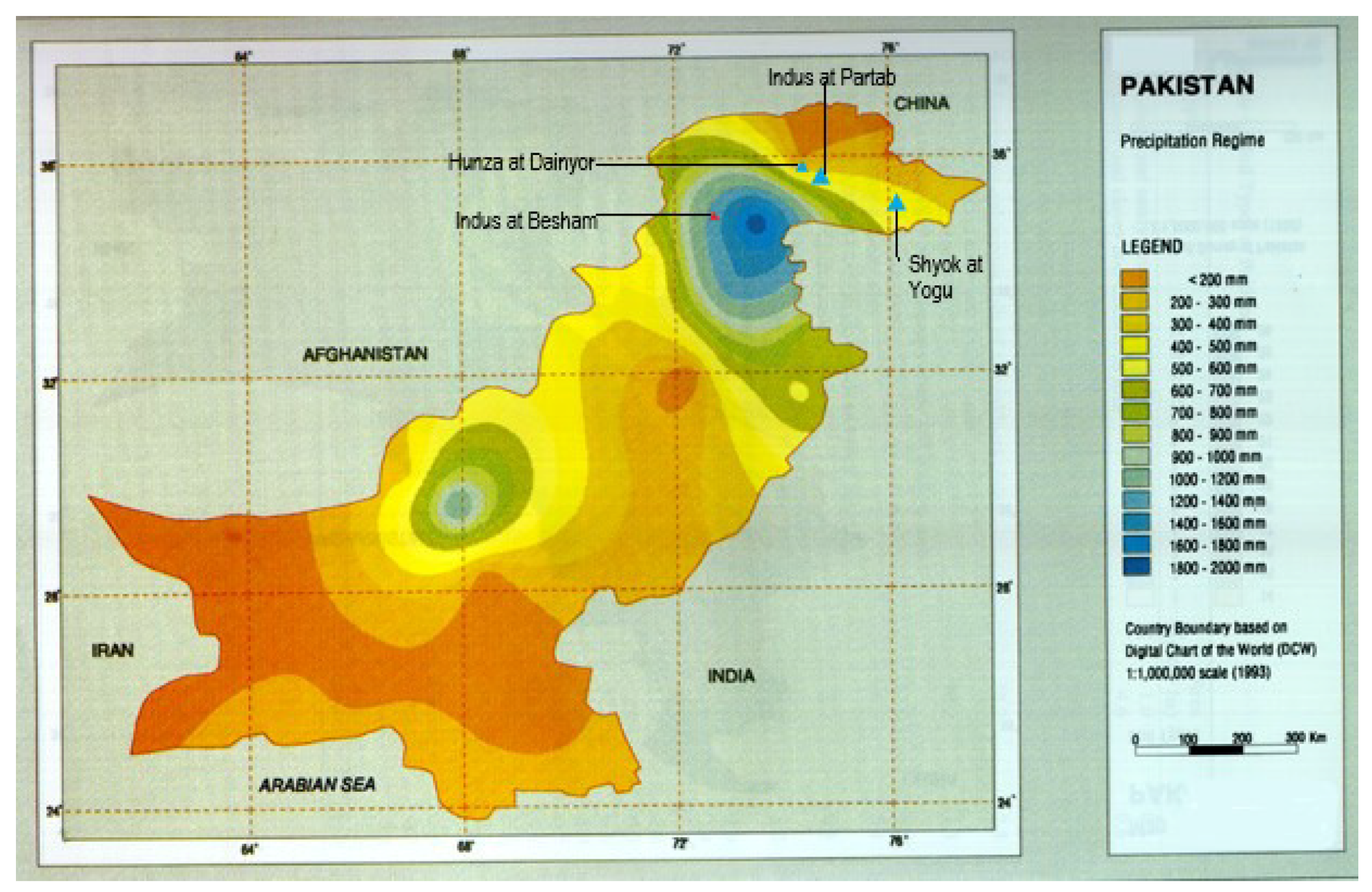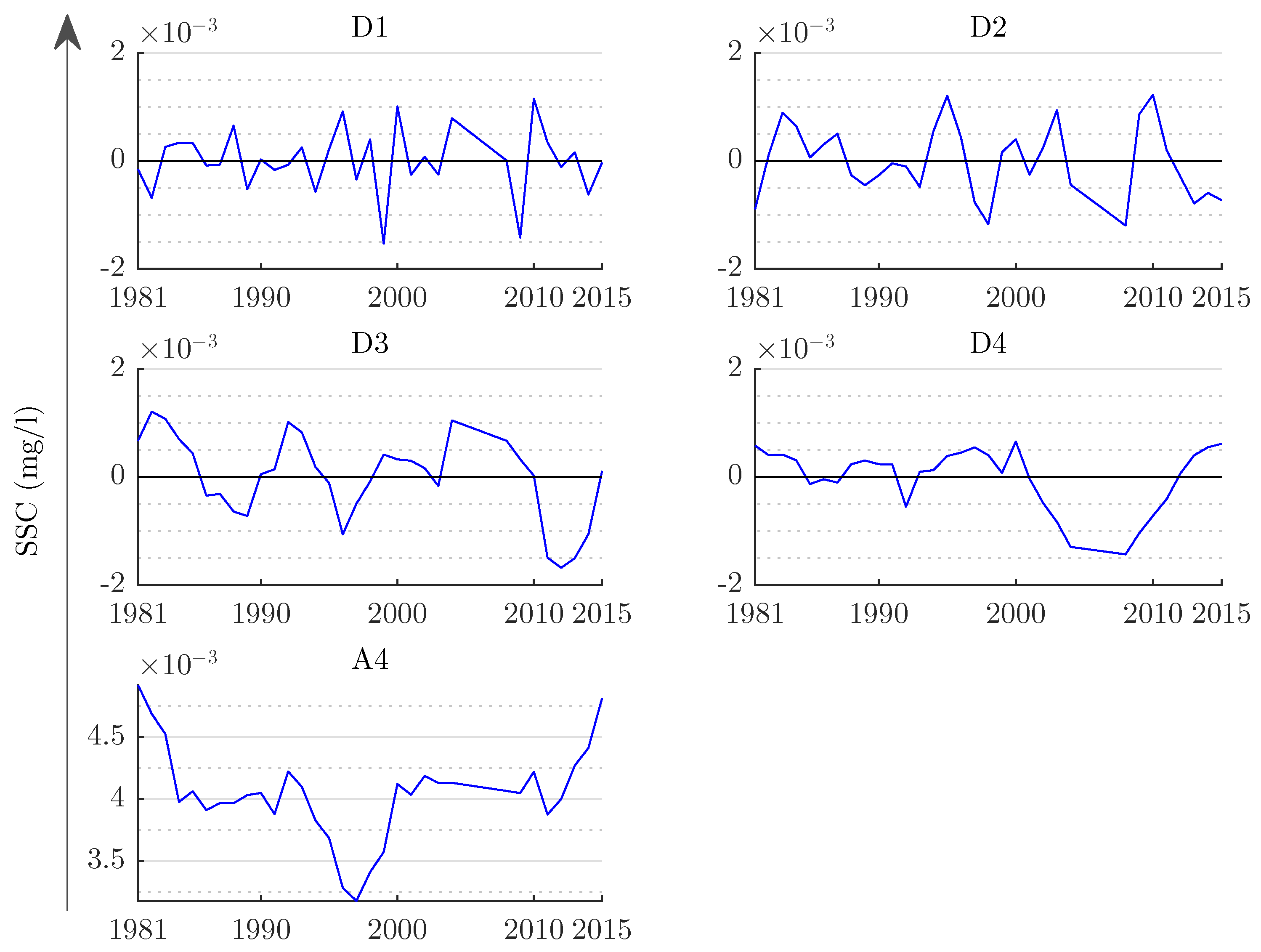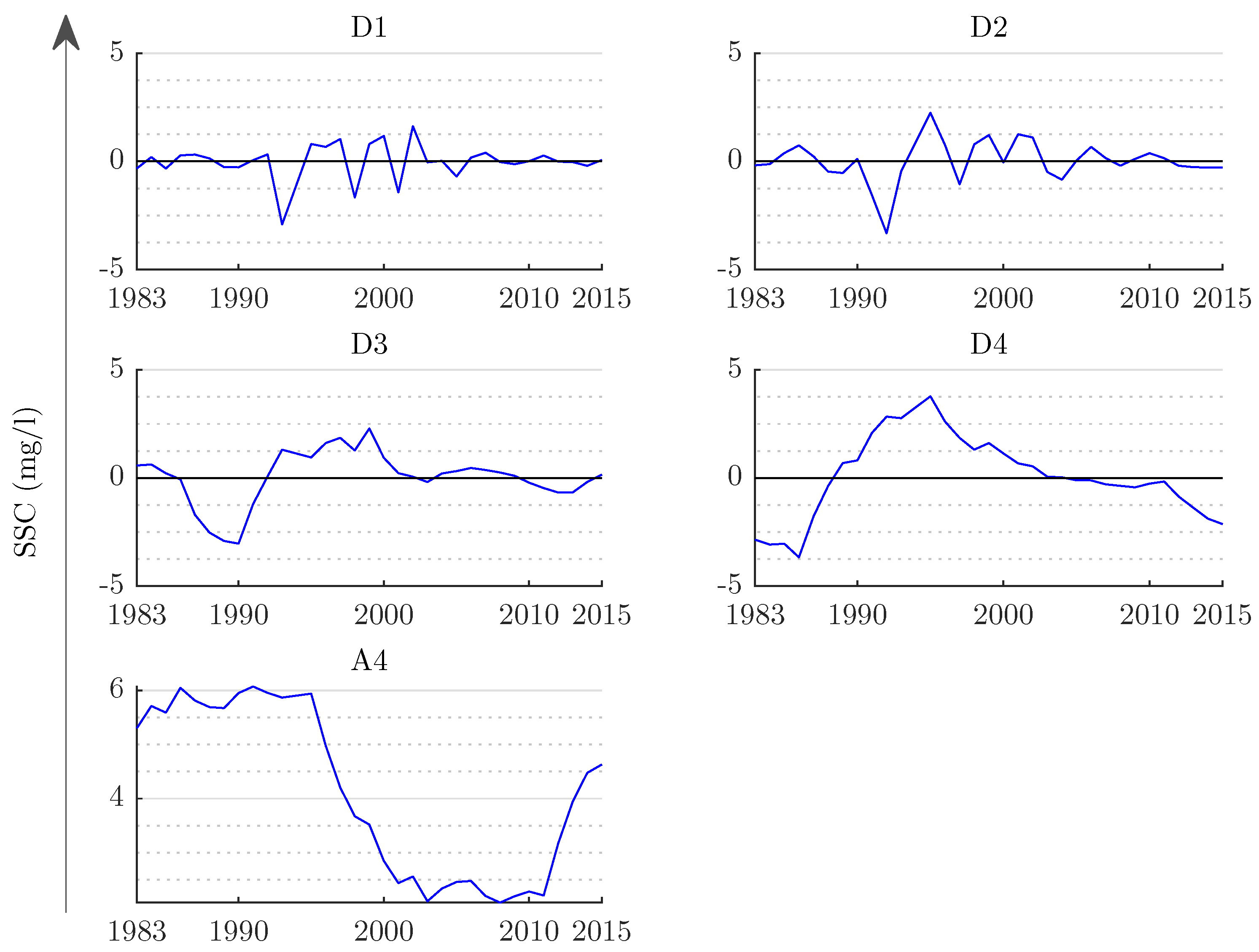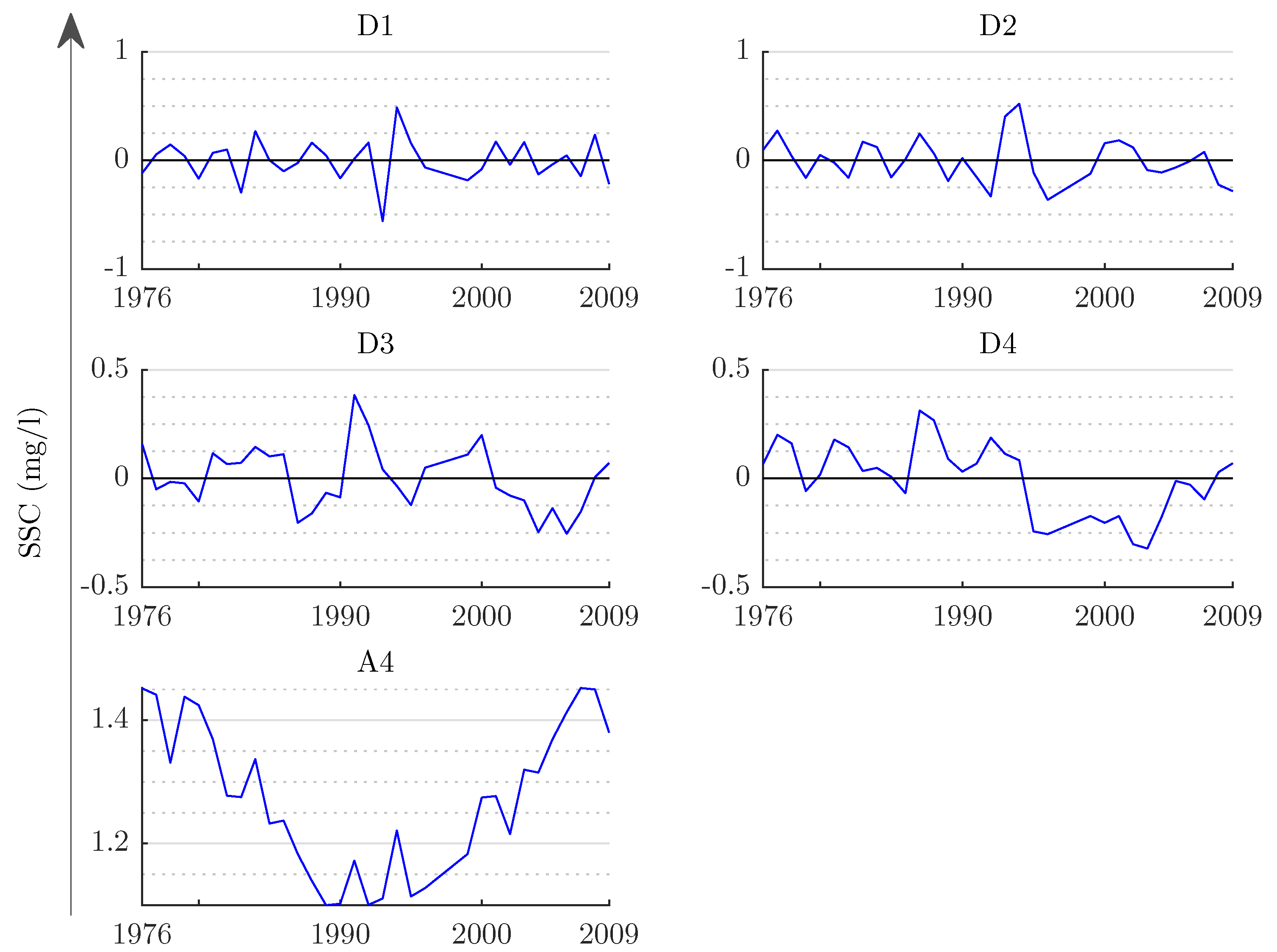Detection of Sediment Trends Using Wavelet Transforms in the Upper Indus River
Abstract
:1. Introduction
2. Study Area and Data
3. Methods
3.1. Wavelet Transform
Discrete Wavelet Analysis
3.2. Trend Estimation
Mann–Kendall Test (MK)
4. Results and Discussion
4.1. Inter-Annual Trends
4.2. Intra-Annual Trends
5. Conclusions
Author Contributions
Acknowledgments
Conflicts of Interest
References
- Khan, F.; Pilz, J.; Amjad, M.; Wiberg, D.A. Climate variability and its impacts on water resources in the Upper Indus Basin under IPCC climate change scenarios. Int. J. Glob. Warm. 2015, 8, 46–69. [Google Scholar] [CrossRef]
- Hasson, S.; Böhner, J.; Lucarini, V. Prevailing climatic trends and runoff response from Hindukush– Karakoram–Himalaya, upper Indus Basin. Earth Syst. Dyn. 2017, 8, 337–355. [Google Scholar] [CrossRef]
- King, R.; Stevens, M. Sediment management at Warsak, Pakistan. Int. J. Hydropower Dams 2001, 8, 61–68. [Google Scholar]
- Montgomery, D.C.; Peck, E.A. Introduction to Linear Regression Analysis; John Wiley: New York, NY, USA; Brisbane, Australia, 1982. [Google Scholar]
- Lman, R.L.; Conover, W.J. A Modern Approach to Statistics; John Wiley: New York, NY, USA; Brisbane, Australia, 1983. [Google Scholar]
- Mann, H. Nonparametric tests against trend. Econmetrica 1945, 13, 245–259. [Google Scholar] [CrossRef]
- Kendall, M.G. Rank Correlation Methods, 4th ed.; Charles Griffin: London, UK, 1975. [Google Scholar]
- Bradley, J.V. Distribution-Free Statistical Tests; Prentice-Hall: Englewood Cliffs, NJ, USA, 1968. [Google Scholar]
- Pettitt, A.N. A non-parametric approach to the change-point problem. J. R. Stat. Soc. Ser. C Appl. Stat. 1979, 28, 126–135. [Google Scholar] [CrossRef]
- Hirsch, R.; Alexander, R.; Smith, R. Selection of Methods for Detection and Estimation of Trends in Water Quality Data. Water Resour. Res. 1991, 27, 803–813. [Google Scholar] [CrossRef]
- Gao, Z.L.; Fu, Y.L.; Li, Y.H.; Liu, J.X.; Chen, N.; Zhang, X.P. Trends of streamflow, sediment load and their dynamic relation for the catchments in the middle reaches of the Yellow River over the past five decades. Hydrol. Earth Syst. Sci. 2012, 16, 3219–3231. [Google Scholar] [CrossRef] [Green Version]
- Ali, K.; de Boer, D. Construction of sediment budgets in large-scale drainage basins: The case of the upper Indus River. Int. Assoc. Hydrol. Sci. Publ. 2003, 279, 206–215. [Google Scholar]
- Adamowski, K.; Prokoph, A.; Adamowski, J. Development of a new method of wavelet aided trend detection and estimation. Hydrol. Process. 2009, 23, 2686–2696. [Google Scholar] [CrossRef]
- Partal, T.; Kucuk, M. Long-term trend analysis using discrete wavelet components of annual precipitations measurements in Marmara region (Turkey). Phys. Chem. Earth 2006, 31, 1189–1200. [Google Scholar] [CrossRef]
- Tan, C.; Huang, B.S.; Liu, K.S.; Chen, H.; Liu, F.; Qiu, J.; Yang, J.X. Using the wavelet transform to detect temporal variations in hydrological processes in the Pearl River, China. Quat. Int. 2017, 440, 52–63. [Google Scholar] [CrossRef]
- Zhang, S.; Lu, X.X.; Higgitt, D.L.; Chen, C.T.A.; Han, J.; Sun, H. Recent changes of water discharge and sediment load in the Zhujiang (Pearl River) Basin, China. Glob. Planet. Chang. 2008, 60, 365–380. [Google Scholar] [CrossRef]
- Govt of Pakisatan. Pakistan Water Sector Strategy. Executive Summary; Report; Ministry of Water and Power, Office of the Chief Engineering Advisor/Chairman Federal Flood Commission, Govt of Pakistan: Islamabad, Pakistan, 2002; Volume 1. [Google Scholar]
- Pakistan Water Gateway. The Pakistan Water Situational Analysis; Report; Consultative Process in Pakistan (WCD CPP) Project; Pakistan Water Gateway. 2005. Avaialble online: http://waterinfo.net.pk/?q=node/788 (accessed on 3 July 2018).
- Ateeq-Ur-Rehman, S.; Bui, M.D.; Rutschmann, P. Variability and trend detection in the sediment load of the Upper Indus River. Water 2018, 10, 16. [Google Scholar] [CrossRef]
- Ali, K.F.; De Boer, D.H. Spatial patterns and variation of suspended sediment yield in the upper Indus River basin, northern Pakistan. J. Hydrol. 2007, 334, 368–387. [Google Scholar] [CrossRef]
- Railean, I.; Moga, S.; Borda, M.; Stolojescu, C.L. A wavelet based prediction method for time series. In Stochastic Modeling Techniques and Data Analysis (SMTDA2010); Janssen, J., Ed.; ASMDA International: Chania, Greece, 2010. [Google Scholar]
- Gilbert, R.O. Statistical Methods for Environmental Pollution Monitoring; John Wiley & Sons: New York, NY, USA, 1987. [Google Scholar]
- Yue, S.; Pilon, P.; Phinney, B.; Cavadias, G. The influence of autocorrelation on the ability to detect trend in hydrological series. Hydrol. Process. 2002, 16, 1807–1829. [Google Scholar] [CrossRef]
- Von Storch, H. Misuses of statistical analysis in climate research. In Analysis of Climate Variability; Springer: New York, NY, USA, 1999; pp. 11–26. [Google Scholar]
- Yue, S.; Wang, C.Y. Regional streamflow trend detection with consideration of both temporal and spatial correlation. Int. J. Climatol. 2002, 22, 933–946. [Google Scholar] [CrossRef] [Green Version]
- Sen, P.K. Estimates of the regression coefficient based on Kendall’s tau. J. Am. Stat. Assoc. 1968, 63, 1379–1389. [Google Scholar] [CrossRef]
- Gibbons, R.D.; Bhaumik, D.; Aryal, S. Statistical Methods for Groundwater Monitoring, 2nd ed.; Statistics in Practice; Wiley: Hoboken, NJ, USA, 2009; p. xxvi. 374p. [Google Scholar]
- Hudson, P. Event sequence and sediment exhaustion in the lower Panuco Basin, Mexico. Catena 2003, 52, 57–76. [Google Scholar] [CrossRef]
- Lutz, A.F.; Immerzeel, W.; Kraaijenbrink, P.; Shrestha, A.B.; Bierkens, M.F. Climate change impacts on the upper Indus hydrology: sources, shifts and extremes. PLoS ONE 2016, 11, e0165630. [Google Scholar] [CrossRef] [PubMed]
- Ali, K.F. Construction of Sediment Budgets in Large Scale Drainage Basins: The Case of the Upper Indus River. Ph.D. Thesis, Department of Geography and Planning, University of Saskatchewan, Saskatoon, SK, Canada, 2009. [Google Scholar]
- Shah, A.A. Earthquake geology of Kashmir Basin and its implications for future large earthquakes. Int. J. Earth Sci. 2013, 102, 1957–1966. [Google Scholar] [CrossRef]
- Ateeq-Ur-Rehman, S.; Bui, M.D.; Rutschmann, P. Detection and estimation of sediment transport trends in the upper Indus River during the last 50 years. In Proceedings of Hydropower: A Vital Source of Sustainable Energy for Pakistan; Center of Excellence in Water Resources Engineering, University of Engineering and Technology: Lahore, Pakistan, 2017; ISBN 978-969-8670-06-01. [Google Scholar]
- Vanmaercke, M.; Kettner, A.J.; Eeckhaut, M.V.D.; Poesen, J.; Mamaliga, A.; Verstraeten, G.; Rãdoane, M.; Obreja, F.; Upton, P.; Syvitski, J.P.; et al. Moderate seismic activity affects contemporary sediment yields. Prog. Phys. Geogr. Earth Environ. 2014, 38, 145–172. [Google Scholar] [CrossRef]
- Kale, V.S. Fluvial geomorphology of Indian rivers: an overview. Prog. Phys. Geogr. Earth Environ. 2002, 26, 400–433. [Google Scholar] [CrossRef]







| Type | Dainyor | Yugo | Partab Bridge | Besham Qila |
|---|---|---|---|---|
| Data series | 1981–2015 | 1983–2015 | 1976–2009 | 1983–2014 |
| Max SSC (suspended sediment concentration) (mg/L) | 21,300 | 35,600 | 25,040 | 28,800 |
| Min SSC (mg/L) | 6 | 10 | 1 | 9 |
| Mean SSC (mg/L) | 1223 | 1330 | 2018 | 1179 |
| SD (standard deviation) SSC (mg/L) | 2397 | 4181 | 2950 | 1747 |
| Max discharge (m3/s) | 1792 | 1199 | 9287 | 18,071 |
| Min discharge (m3/s) | 22 | 859 | 168 | 362 |
| Mean discharge (m3/s) | 362 | 1041 | 2126 | 3221 |
| SD discharge (m3/s) | 397 | 103 | 2119 | 2978 |
| Jan | Feb | Mar | Apr | May | Jun | Jul | Aug | Sep | Oct | Nov | Dec | |
|---|---|---|---|---|---|---|---|---|---|---|---|---|
| Dainyor | ||||||||||||
| Original series: | 2.385 | 3.033 | 1.508 | −0.454 | −0.195 | −0.681 | −3.584 | −3.811 | −1.784 | −1.963 | 1.396 | 1.136 |
| D1 + A4 | 1.371 | 1.704 | 1.135 | 2.254 | 0.114 | −1.670 | −0.811 | −0.568 | 0.714 | −0.868 | 0.900 | 0.609 |
| D2 + A4 | 1.655 | 2.013 | 1.573 | 1.962 | 0.422 | −1.297 | −0.519 | −0.892 | 0.811 | −0.673 | 1.395 | 0.803 |
| D3 + A4 | 0.714 | 1.964 | 1.606 | 2.238 | 0.795 | −2.173 | −1.054 | −0.665 | 0.892 | −1.468 | 1.233 | 1.460 |
| D4 + A4 | 2.069 | 2.410 | 1.800 | 1.703 | 0.835 | −1.654 | −1.646 | −2.595 | 0.114 | −3.260 | 1.063 | −0.949 |
| D1 + D2 + A4 | 1.200 | 1.423 | 1.076 | 1.530 | 0.114 | −0.903 | −0.665 | −0.870 | 0.254 | −0.611 | 0.790 | 0.590 |
| D1 + D3 + A4 | 0.573 | 1.390 | 1.097 | 1.714 | 0.362 | −1.487 | −1.022 | −0.719 | 0.308 | −1.141 | 0.681 | 1.027 |
| D1 + D4 + A4 | 1.476 | 1.688 | 1.227 | 1.357 | 0.389 | −1.141 | −1.416 | −2.005 | −0.211 | −2.336 | 0.568 | −0.578 |
| D1 + D2 + D3 + A4 | 0.860 | 1.677 | 1.416 | 1.741 | 0.400 | −1.276 | −1.146 | −1.211 | 0.086 | −1.173 | 0.871 | 1.211 |
| D1 + D2 + D4 + A4 | 1.763 | 1.975 | 1.546 | 1.384 | 0.427 | 0.930 | −1.541 | −2.497 | −0.432 | −2.368 | 0.757 | −0.395 |
| D1 − D4 + A4 | 0.853 | 1.337 | 1.132 | 0.957 | 0.428 | −0.782 | −1.213 | 1.703 | −0.360 | −1.758 | 0.503 | 0.136 |
| D2 + D3 + A4 | 0.763 | 1.596 | 1.389 | 1.519 | 0.568 | −1.238 | −0.827 | −0.935 | 0.373 | −1.011 | 1.011 | 1.157 |
| D2 + D4 + A4 | 1.666 | 1.893 | 1.519 | 1.162 | 0.595 | −0.892 | −1.222 | −2.222 | −0.146 | −2.206 | 0.898 | −0.449 |
| D2 + D3 + D4 + A4 | 0.994 | 1.611 | 1.395 | 1.030 | 0.661 | −0.949 | −1.277 | −1.922 | −0.235 | −2.076 | 0.734 | 0.130 |
| D3 + D4 + A4 | 1.038 | 1.861 | 1.541 | 1.346 | 0.843 | −1.476 | −1.579 | −2.070 | −0.092 | −2.736 | 0.790 | −0.011 |
| Yugo | ||||||||||||
| Original series: | 0.573 | 0.238 | −0.341 | 1.897 | 0.325 | −0.2481 | −0.924 | −1.865 | −1.284 | 0.232 | 0.089 | 0.032 |
| D1 + A4 | - | - | −2.149 | −1.468 | −1.135 | −1.881 | −2.246 | −2.205 | - | - | - | −1.971 |
| D2 + A4 | - | - | −1.963 | −1.192 | −0.405 | −2.092 | −2.100 | −2.351 | - | - | - | −1.922 |
| D3 + A4 | - | - | −1.509 | −0.535 | −1.719 | −2.205 | −2.246 | −2.14 | - | - | - | −1.614 |
| D4 + A4 | - | - | −2.530 | 0.738 | −0.925 | -3.00 | −2.417 | −1.524 | - | - | - | −1.533 |
| D1 + D2 + A4 | - | - | −1.363 | −0.935 | −0.265 | −1.627 | −1.535 | −1.681 | - | - | - | −1.276 |
| D1 + D3 + A4 | - | - | −1.060 | −0.497 | −1.141 | −1.703 | −1.633 | −1.541 | - | - | - | −1.070 |
| D1 + D4 + A4 | - | - | −1.741 | 0.352 | −0.611 | −2.232 | −1.746 | −1.130 | - | - | - | −1.016 |
| D1 + D2 + D3 + A4 | - | - | −0.990 | −0.454 | −0.649 | −2.076 | −1.670 | −1.751 | - | - | - | −1.033 |
| D1 + D2 + D4 + A4 | - | - | −1.671 | 0.395 | −0.119 | −2.605 | −1.784 | −1.341 | - | - | - | −0.979 |
| D1 − D4 + A4 | - | - | −0.779 | 0.526 | −0.302 | −1.832 | −1.151 | −0.846 | - | - | - | −0.441 |
| D2 + D3 + A4 | - | - | −0.936 | −0.314 | −0.654 | −1.843 | −1.535 | −1.638 | - | - | - | −1.038 |
| D2 + D4 + A4 | - | - | −1.617 | 0.535 | −0.125 | −2.373 | −1.649 | −1.227 | - | - | - | −0.984 |
| D2 + D3 + D4 + A4 | - | - | −0.933 | 0.762 | −0.381 | −2.116 | −1.338 | −0.973 | - | - | - | −0.555 |
| D3 + D4 + A4 | - | - | −1.314 | 0.973 | −1.000 | −2.449 | −1.746 | −1.087 | - | - | - | −0.778 |
| Partab Bridge | ||||||||||||
| Original series: | 4.332 | 4.412 | 2.450 | 2.303 | −0.665 | 0.616 | −0.114 | 0.341 | 0.616 | 1.281 | 2.336 | 3.748 |
| D1 + A4 | 0.154 | 1.176 | 1.346 | 0.341 | 0.697 | 1.573 | 1.930 | 0.811 | 0.478 | −0.592 | −1.802 | −0.365 |
| D2 + A4 | 0.479 | 0.957 | 1.046 | 0.584 | 0.122 | 1.589 | 1.557 | 0.649 | 0.154 | −0.381 | −1.218 | 0.105 |
| D3 + A4 | 1.275 | 1.217 | 1.144 | 1.200 | 0.884 | 1.703 | 1.362 | 1.005 | 1.014 | 0.463 | 0.024 | 0.479 |
| D4 + A4 | 2.378 | 2.150 | 1.873 | 1.306 | −1.200 | 0.957 | 1.914 | 0.373 | 0.592 | 1.679 | −0.219 | 1.614 |
| D1 + D2 + A4 | 0.384 | 0.844 | 1.130 | 0.297 | −0.027 | 1.076 | 1.324 | 0.622 | 0.270 | −0.341 | −0.969 | 0.092 |
| D1 + D3 + A4 | 0.915 | 1.017 | 1.195 | 0.708 | 0.481 | 1.151 | 1.195 | 0.859 | 0.843 | 0.222 | −0.141 | 0.341 |
| D1 + D4 + A4 | 1.650 | 1.639 | 1.682 | 0.779 | −0.908 | 0.654 | 1.562 | 0.438 | 0.562 | 1.033 | −0.303 | 1.098 |
| D1 + D2 + D3 + A4 | 1.196 | 1.076 | 1.427 | 0.778 | −0.011 | 1.178 | 1.232 | 0.941 | 0.795 | 0.276 | 0.092 | 0.676 |
| D1 + D2 + D4 + A4 | 1.931 | 1.698 | 1.914 | 0.849 | −1.400 | 0.681 | 1.600 | 0.519 | 0.514 | 1.087 | −0.070 | 1.433 |
| D1 −D4 + A4 | 1.646 | 1.158 | 1.327 | 0.798 | −0.830 | 0.470 | 0.905 | 0.503 | 0.623 | 1.022 | 0.594 | 1.210 |
| D2 + D3 + A4 | 1.131 | 0.871 | 0.995 | 0.870 | 0.097 | 1.162 | 0.946 | 0.751 | 0.627 | 0.362 | 0.249 | 0.654 |
| D2 + D4 + A4 | 1.866 | 1.493 | 1.481 | 0.941 | −1.292 | 0.665 | 1.314 | 0.330 | 0.346 | 1.174 | 0.087 | 1.411 |
| D2 + D3 + D4 + A4 | 2.009 | 1.294 | 1.334 | 1.066 | −0.957 | 0.576 | 0.916 | 0.486 | 0.653 | 1.343 | 0.860 | 1.497 |
| D3 + D4 + A4 | 2.398 | 1.666 | 1.546 | 1.352 | −0.784 | 0.741 | 1.184 | 0.568 | 0.919 | 1.736 | 0.915 | 1.660 |
| Besham Qila | ||||||||||||
| Original series: | 1.721 | 2.794 | 1.347 | 0.714 | 0.890 | −0.211 | −1.022 | −2.060 | −2.838 | −0.925 | 0.455 | 0.227 |
| D1 + A4 | 0.081 | 1.647 | 0.982 | −1.760 | −0.835 | −0.949 | − 1.297 | −1.362 | − 1.225 | −1.468 | −1.501 | − 0.747 |
| D2 + A4 | 0.235 | 1.769 | 0.641 | −1.330 | − 0.584 | −0.892 | −1.695 | −1.930 | −1.565 | −1.225 | −1.477 | − 0.511 |
| D3 + A4 | 0.657 | 1.899 | 0.138 | −0.835 | −0.211 | −0.997 | −2.214 | −2.343 | −1.743 | −1.760 | −1.143 | −0.730 |
| D4 + A4 | 0.008 | 1.712 | 1.509 | −1.898 | −2.805 | −1.038 | −2.546 | −2.659 | −2.879 | −2.320 | −2.410 | −3.125 |
| D1 + D2 + A4 | 0.325 | 1.331 | 0.368 | −0.687 | −0.195 | −0.616 | −0.822 | −1.065 | −0.800 | −0.671 | −0.611 | −0.141 |
| D1 + D3 + A4 | 0.606 | 1.417 | 0.032 | −0.357 | 0.054 | −0.687 | − 1.168 | −1.341 | −0.919 | −1.027 | −0.389 | −0.287 |
| D1 + D4 + A4 | 0.173 | 1.293 | 0.946 | −1.065 | −1.676 | −0.714 | −1.389 | −1.551 | −1.676 | −1.401 | 1.234 | −1.883 |
| D1 + D2 + D3 + A4 | 0.877 | 1.650 | −0.254 | 0.130 | 0.416 | −0.670 | −1.124 | −1.497 | −0.903 | −0.719 | 0.000 | 0.070 |
| D1 + D2 + D4 + A4 | 0.444 | 1.526 | 0.660 | −0.579 | −1.314 | −0.697 | −1.346 | −1.708 | −1.660 | −1.093 | −0.844 | −1.526 |
| D1 − D4 + A4 | 0.597 | 1.107 | 0.023 | 0.143 | −0.422 | −0.451 | −0.989 | −1.284 | −1.057 | −0.685 | −0.139 | −0.789 |
| D2 + D3 + A4 | 0.709 | 1.499 | −0.195 | −0.070 | 0.222 | −0.649 | −1.432 | −1.719 | −1.146 | −0.865 | −0.373 | −0.130 |
| D2 + D4 + A4 | 0.276 | 1.374 | 0.719 | −0.779 | −1.508 | −0.676 | −1.654 | −1.930 | −1.903 | −1.239 | −1.217 | −1.726 |
| D2 + D3 + D4 + A4 | 0.621 | 1.270 | 0.073 | 0.028 | −0.673 | −0.547 | −1.468 | −1.772 | −1.504 | −0.965 | −0.454 | −1.136 |
| D3 + D4 + A4 | 0.557 | 1.461 | 0.384 | −0.449 | −1.259 | −0.746 | −2.000 | −2.205 | −2.022 | −1.595 | −0.995 | −1.872 |
© 2018 by the authors. Licensee MDPI, Basel, Switzerland. This article is an open access article distributed under the terms and conditions of the Creative Commons Attribution (CC BY) license (http://creativecommons.org/licenses/by/4.0/).
Share and Cite
Tarar, Z.R.; Ahmad, S.R.; Ahmad, I.; Majid, Z. Detection of Sediment Trends Using Wavelet Transforms in the Upper Indus River. Water 2018, 10, 918. https://doi.org/10.3390/w10070918
Tarar ZR, Ahmad SR, Ahmad I, Majid Z. Detection of Sediment Trends Using Wavelet Transforms in the Upper Indus River. Water. 2018; 10(7):918. https://doi.org/10.3390/w10070918
Chicago/Turabian StyleTarar, Zeeshan Riaz, Sajid Rashid Ahmad, Iftikhar Ahmad, and Zahra Majid. 2018. "Detection of Sediment Trends Using Wavelet Transforms in the Upper Indus River" Water 10, no. 7: 918. https://doi.org/10.3390/w10070918





